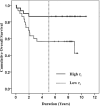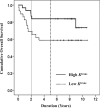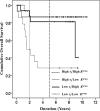Dynamic Contrast-Enhanced MRI-Derived Intracellular Water Lifetime (τ i ): A Prognostic Marker for Patients with Head and Neck Squamous Cell Carcinomas
- PMID: 29146716
- PMCID: PMC5766394
- DOI: 10.3174/ajnr.A5440
Dynamic Contrast-Enhanced MRI-Derived Intracellular Water Lifetime (τ i ): A Prognostic Marker for Patients with Head and Neck Squamous Cell Carcinomas
Abstract
Background and purpose: Shutter-speed model analysis of dynamic contrast-enhanced MR imaging allows estimation of mean intracellular water molecule lifetime (a measure of cellular energy metabolism) and volume transfer constant (a measure of hemodynamics). The purpose of this study was to investigate the prognostic utility of pretreatment mean intracellular water molecule lifetime and volume transfer constant in predicting overall survival in patients with squamous cell carcinomas of the head and neck and to stratify p16-positive patients based upon survival outcome.
Materials and methods: A cohort of 60 patients underwent dynamic contrast-enhanced MR imaging before treatment. Median, mean intracellular water molecule lifetime and volume transfer constant values from metastatic nodes were computed from each patient. Kaplan-Meier analyses were performed to associate mean intracellular water molecule lifetime and volume transfer constant and their combination with overall survival for the first 2 years, 5 years, and beyond (median duration, >7 years).
Results: By the last date of observation, 18 patients had died, and median follow-up for surviving patients (n = 42) was 8.32 years. Patients with high mean intracellular water molecule lifetime (4 deaths) had significantly (P = .01) prolonged overall survival by 5 years compared with those with low mean intracellular water molecule lifetime (13 deaths). Similarly, patients with high mean intracellular water molecule lifetime (4 deaths) had significantly (P = .006) longer overall survival at long-term duration than those with low mean intracellular water molecule lifetime (14 deaths). However, volume transfer constant was a significant predictor for only the 5-year follow-up period. There was some evidence (P < .10) to suggest that mean intracellular water molecule lifetime and volume transfer constant were associated with overall survival for the first 2 years. Patients with high mean intracellular water molecule lifetime and high volume transfer constant were associated with significantly (P < .01) longer overall survival compared with other groups for all follow-up periods. In addition, p16-positive patients with high mean intracellular water molecule lifetime and high volume transfer constant demonstrated a trend toward the longest overall survival.
Conclusions: A combined analysis of mean intracellular water molecule lifetime and volume transfer constant provided the best model to predict overall survival in patients with squamous cell carcinomas of the head and neck.
© 2018 by American Journal of Neuroradiology.
Figures






References
Publication types
MeSH terms
Substances
Grants and funding
LinkOut - more resources
Full Text Sources
Other Literature Sources
Medical
